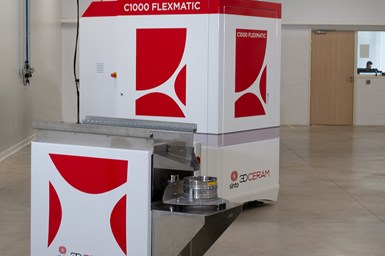3D Printing Helps Push the Boundaries for Green Energy
Partners in the European HyP3D project say they have reached a breakthrough in high-pressure hydrogen production through 3D printing.
3DCeram’s C1000 Flexmatic industrial ceramic printer is a part of the HyP3D project’s semiautomatic production line. The Photo Credit: 3dCERAM
Participants in the European HyP3D project say the endeavor has emerged as a trailblazing initiative set to redefine the landscape of hydrogen production. Leveraging 3D printing manufacturing techniques, the project aims to showcase the viability of a disruptive high-pressure Solid Oxide Electrolysis Cell (SOEC) technology, promising efficiency and sustainability.
At the core of the HyP3D project lies the goal of delivering an ultracompact, high-pressure standalone SOEC stack capable of converting electricity into compressed hydrogen. Unlike conventional methods, the HyP3D aims to develop a technology that harnesses the power of 3D printed SOEC cells with a substantial active area of 70 cm², embedded functionalities and the capacity to achieve hydrogen production at remarkably high current densities exceeding 0.90A/cm² (~1.3V) under conditions of 850°C and 5-plus bar pressure.
The group says the manufacturing breakthrough achieved by HyP3D presents a paradigm shift from traditional ceramics SOEC processing. The outcome is the creation of ultrahigh power density SOEC stacks, boasting a power output of 2.14 kW within a compact volume of 630 cm³. It is said this achievement will translate to a threefold increase in specific power per unit volume (3.4 kW/L) and a fourfold rise in specific power per unit mass (1.10 kW/kg), outstripping existing benchmarks.
One of the collaborators in the HyP3D project is H2B2, an organization specializing in all aspects of hydrogen production systems. Armed with expertise in energy efficiency and cost-reduction strategies, H2B2’s involvement aims to elevate the project’s success. The company’s ownership of the manufacturing pilot line streamlines the production of HyP3D cells.
3DCeram is another collaborator whose project’s work plan and methodology entail an intricate optimization process spanning printable feedstock, 3D printing parameters and thermal treatments. By formulating specialized slurries for SLA 3D printing utilizing commercial YSZ powders, the teams are delving into the rheological behavior and printing tests. The innovation extends to designing optimal procedures, culminating in the production of complex-shaped parts mirroring the final cell dimensions.
To successfully carry out this project, 3DCeram will conduct this work using the C1000 Flexmatic, the latest semiautomatic production line. The printer features a 320 × 320 mm build platform that aligns with the project’s industrial ambitions. Moreover, it is said the industrialization possibilities offered by the C1000 Flexmatic are essential for the successful completion of the project.
HyP3D’s vision doesn’t stop at materializing dense, mechanically robust components. Collaborators 3DCeram and IREC are focused on formulating optimal printing strategies, ensuring reliability and maximizing production yield. The project aligns with the broader objectives of advancing the hydrogen economy, reducing time-to-market significantly, slashing raw material consumption by 76% and minimizing the initial investment by 42% compared to conventional manufacturing processes.
With this HyP3D initiative, the energy sector can witness a convergence of 3D printing prowess and hydrogen innovation, propelling the world toward a more sustainable energy future.
- Read about another 3DCeram ceramic printer, this one for development, prototypes. The printer is designed for ease of use, offering plug and play for ceramic 3D printing.
Related Content
10 Important Developments in Additive Manufacturing Seen at Formnext 2022 (Includes Video)
The leading trade show dedicated to the advance of industrial 3D printing returned to the scale and energy not seen since before the pandemic. More ceramics, fewer supports structures and finding opportunities in wavelengths — these are just some of the AM advances notable at the show this year.
Read MoreHow Norsk Titanium Is Scaling Up AM Production — and Employment — in New York State
New opportunities for part production via the company’s forging-like additive process are coming from the aerospace industry as well as a different sector, the semiconductor industry.
Read MoreCasting With Complexity: How Casting Plus 3D Printing Combine the Strengths of Both
Aristo Cast is advancing a mode of part production in which casting makes the part, but 3D printing enables the geometry.
Read MoreLarge-Format “Cold” 3D Printing With Polypropylene and Polyethylene
Israeli startup Largix has developed a production solution that can 3D print PP and PE without melting them. Its first test? Custom tanks for chemical storage.
Read MoreRead Next
3D Printing Brings Sustainability, Accessibility to Glass Manufacturing
Australian startup Maple Glass Printing has developed a process for extruding glass into artwork, lab implements and architectural elements. Along the way, the company has also found more efficient ways of recycling this material.
Read MoreHybrid Additive Manufacturing Machine Tools Continue to Make Gains (Includes Video)
The hybrid machine tool is an idea that continues to advance. Two important developments of recent years expand the possibilities for this platform.
Read More4 Ways the Education and Training Challenge Is Different for Additive Manufacturing
The advance of additive manufacturing means we need more professionals educated in AM technology.
Read More






















